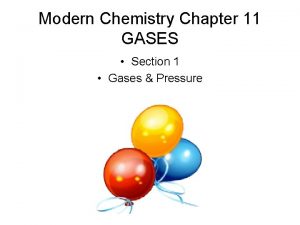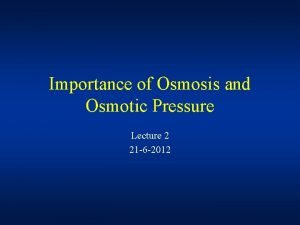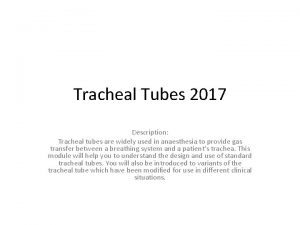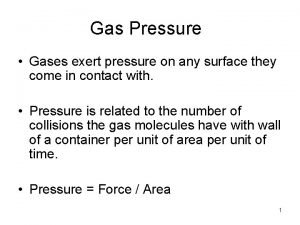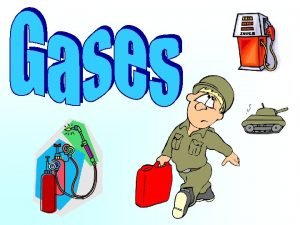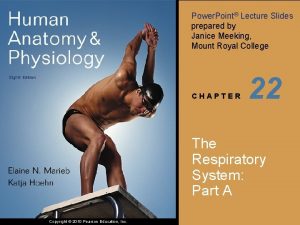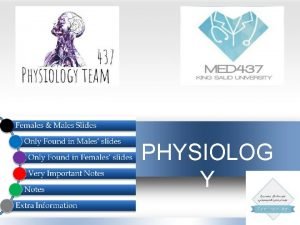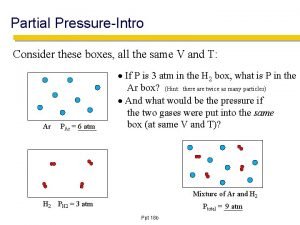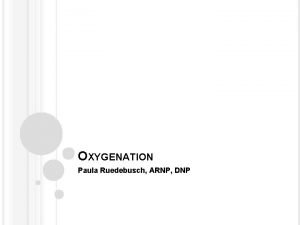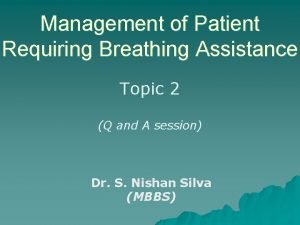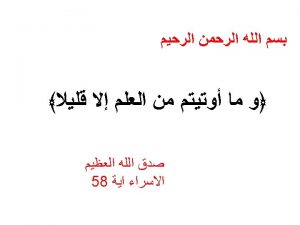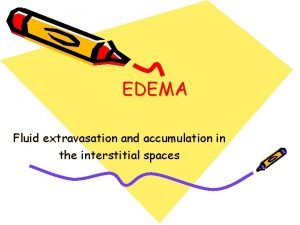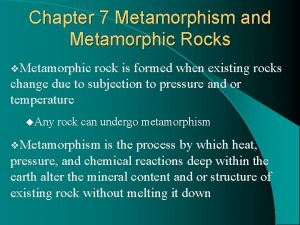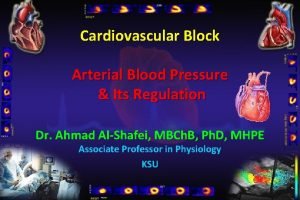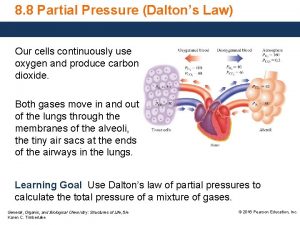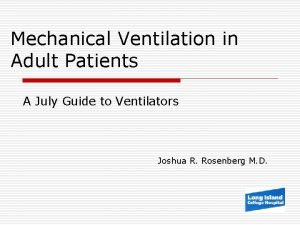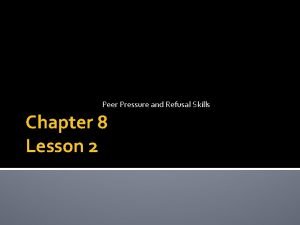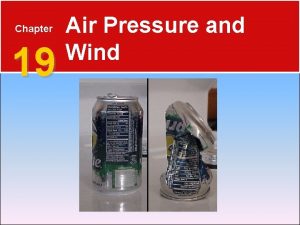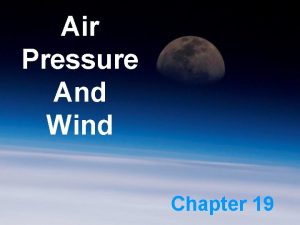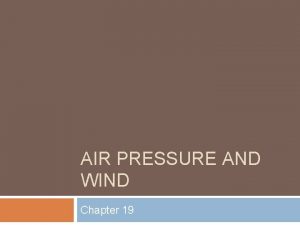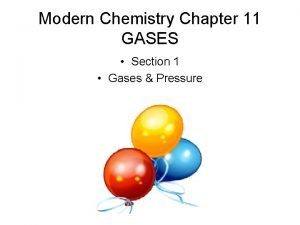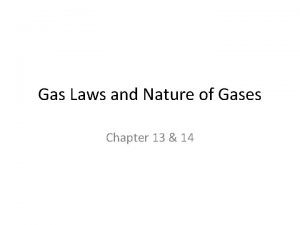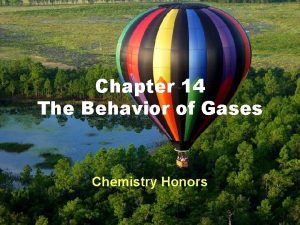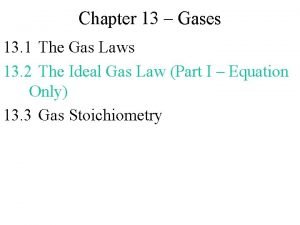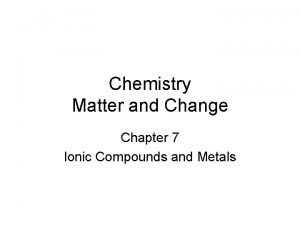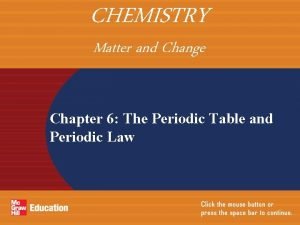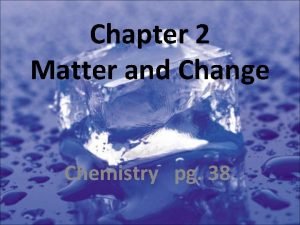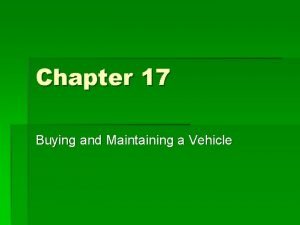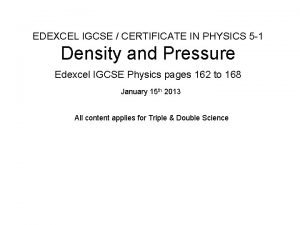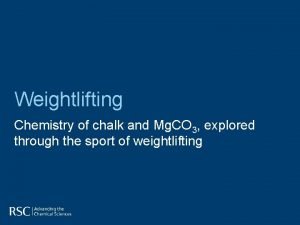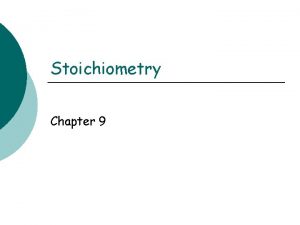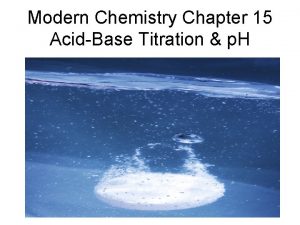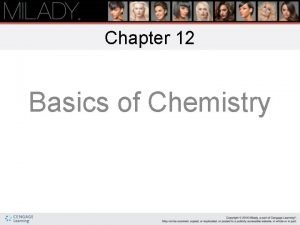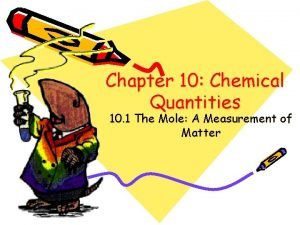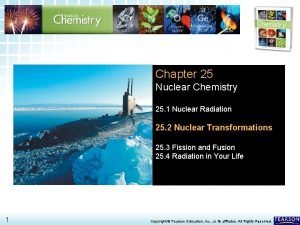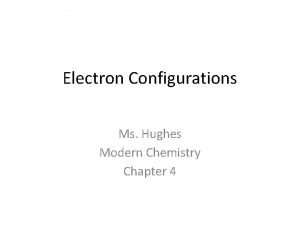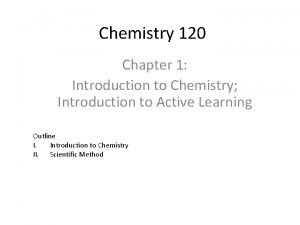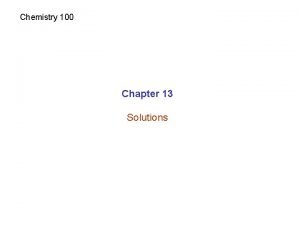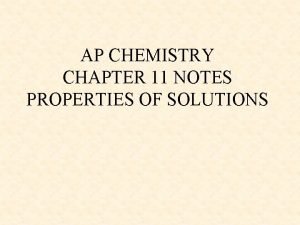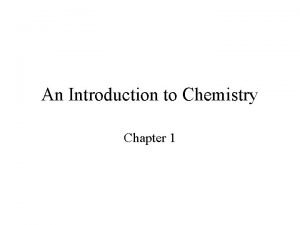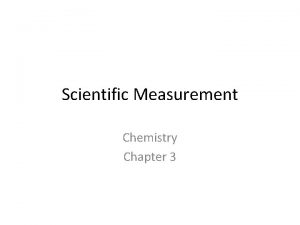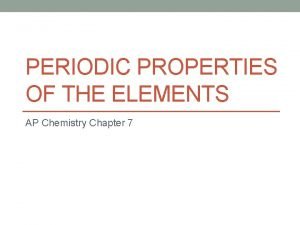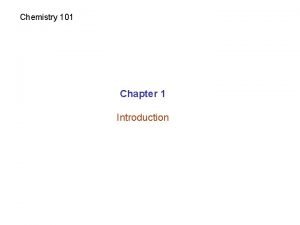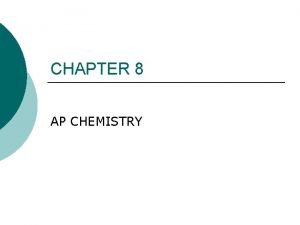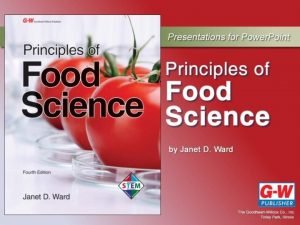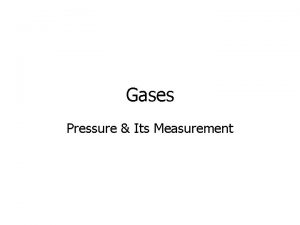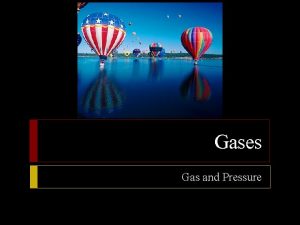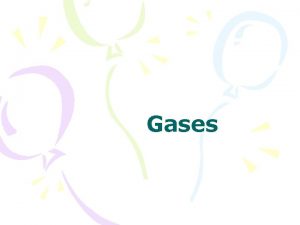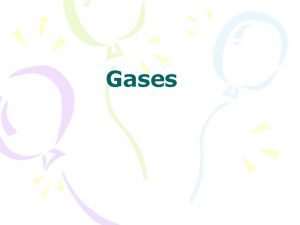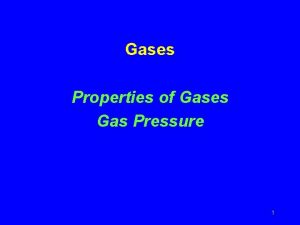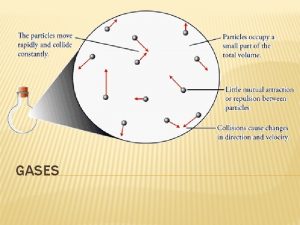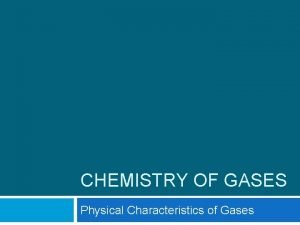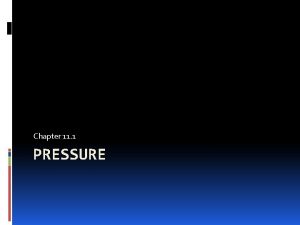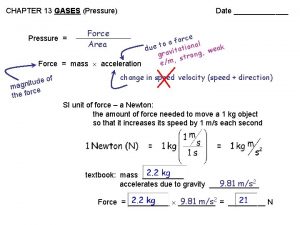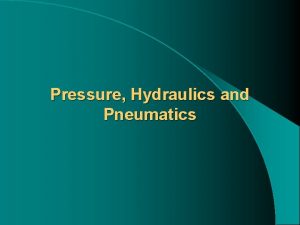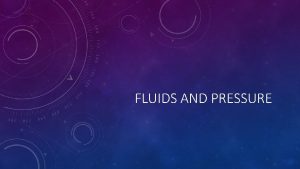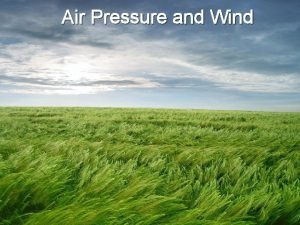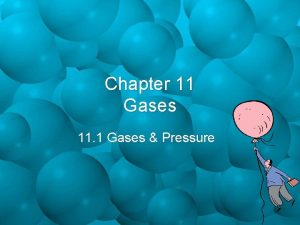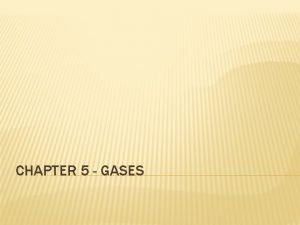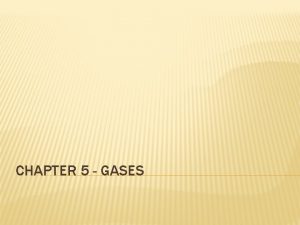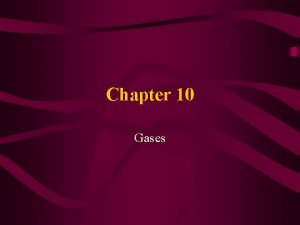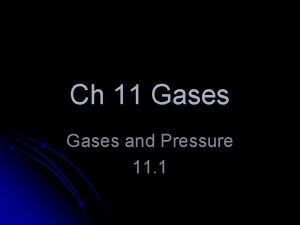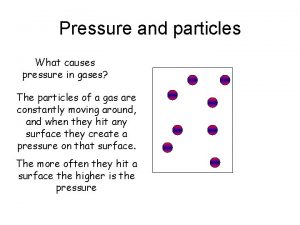Gases Chapter 11 Chemistry Gases and Pressure 11
























































































- Slides: 88

Gases Chapter 11 Chemistry

Gases and Pressure 11 -1

11 -1 Learning Targets § § § Define pressure Describe how pressure is measured Convert between different units of pressure Define STP Apply Dalton’s Law of Partial Pressure

KMT § Kinetic Molecular Theory (KMT)particles of matter are always in constant motion § Explains behavior of solids, liquids, gases § relates to ideal gas § Ideal gas- imaginary gas that perfectly fits all assumptions of the KMT

KMT (Kinetic Molecular Theory) based on five assumptions: § 1 - gases consist of large numbers of tiny particles that are far apart relative to their size – Molecules farther apart than molecules in other states – Most volume occupied by gas is empty space – Allows for low density and easy compression

§ 2 - Collisions between gas particles and between particles and container are elastic § (Elastic collision- no net loss of kinetic energy) – Total kinetic energy of two particles remains the same as long as temp is constant

§ 3 - Gas particles are in constant, rapid, random motion – Particles move in all directions – Move in straight lines until collide with each other or container walls

§ 4 - No forces of attraction or repulsion between gas particles – When collide do not stick, but immediately bounce apart

§ 5 - The temperature of a gas depends on the average kinetic energy of the particles of the gas § KE= ½ mv 2 – If same gas, same mass, so KE depends only on speed – KE increases as temp increases – All gases at same temp have same average KE – At same temp lighter particles have higher average speeds

Kinetic Molecular Theory § 1 -gas consists of tiny particles § 2 -there size is so small and the distance between them so great their volume is zero § 3 -random constant motion causes pressure § 4 -particles do not attract or repel § 5 -average KE is directly proportional to Temp (K)

Physical Properties of Gasesexplained by KMT § Expansion- completely fill container – No definite shape – No definite volume § Fluidity- flows – Due to attractive forces between gas molecules are insignificant – Slide pass each other

§ Compressible – Volume greatly decreased § Low density – 1/1000 the density of the same substance in the liquid or solid state § Gases exert pressure

Real gas § Gas that does not behave completely according to the assumptions of KMT § Deviates from ideal gas behavior § The more polar a gas the more likely acts as real gas § Nobel gases, diatomic, non polar most like ideal gas

§ At very low temp and high pressures deviation from KMT is considerable § At high temp and low pressure real gases act most like ideal gases

Pressure § Pressure (P)- Force per unit area of a surface § P= force (N) /area (m 2)= Pascal (Pa) § – Area Average atmospheric pressure= 760 mm Hg, 0º C at sea level

Barometer § § § § Measures atmospheric pressure Invented in 1643, Evangelista Torricelli (Italian) Student of Galileo Made by filling glass tube with mercury and inverting in a dish of mercury (p 351) Weight of atmosphere change column height Column of air has mass Pressure changes with altitude Aneroid barometer is similar

Barometer

Manometer § -Measures pressure of gas in container § p. 351

Manometer

Units of Pressure § mm. Hg- millimeter of mercury § Torr- in honor of Torncelli – these both measure same thing, used interchangeably § Standard atmosphere (atm) § Pascal (Pa) , SI unit for pressure – small, don’t use often § PSI- used in engineering

Pressure Conversions § § § MUST KNOW 1. 0 atm= 760. 0 mm. Hg= 760. 0 torr 1. 0 torr=1 mm. Hg 1. 0 atm= 101, 325 Pa (101. 325 k. Pa) 1. 0 atm = 14. 69 PSI

§ ? atm = 820. torr x 1. 0 atm 760 torr = 1. 08 atm § ? torr = 1. 25 atm x 760. 0 torr = 950. torr 1. 00 atm § ? Pa = 1. 9 atm x 101, 325 Pa = 1. 9 x 105 Pa 1. 0 atm § ? KPa = 1. 9 x 105 Pa = 190 KPa

Standard Temperature and Pressure § STP= 1 atm and 0 ºC

Dalton’s Law of Partial Pressures § For a mixture of gases in a container, the total pressure equals the sum of pressures of all the individual gases – True regardless of the number of different gases present – Each gas behaves as if alone § § § Partial pressure= pressure of gas alone Dalton’s Law of Partial Pressure P total = P 1 + P 2 + P 3 …. .

Dalton’s Law

A mixture of gases at high temperature is created. Suppose that gas X has a pressure of 50 atm, gas Y has a pressure of 20 atm, and gas Z has a pressure of 10 atm. What is the total pressure in this system? § § § P total = P 1 + P 2 + P 3 …. . P total = 50 atm + 20 atm + 10 atm = 80 atm

Gases collected by Water displacement § Gases typically collected over water in lab – Not pure, mixed with water vapor – Pressure of gas and water vapor § P atm = P gas + P water – Atmospheric pressure is from a barometer in lab – P water can be found in a reference table/book, make sure at temp of experiment


§ Hydrogen gas is collected over water at 20. 0 ºC. The partial pressure of hydrogen is determined to be 742. 5 torr. What is the barometric pressure at the time the gas was collected? § P atm = P gas + P water § P atm = 742. 5 torr + 17. 5 torr (found in table B-8 in book p R 79, make sure in correct units) § P atm= 760. 0 torr

§ Helium gas is collected over water at 25 ºC. What is the partial pressure of the helium, given that the barometric pressure is 750. 0 mm. Hg? § P atm = P gas + P water § 750. 0 mm Hg= P gas + 23. 8 mm. Hg § 726. 2 mm Hg

§ A 250. ml sample of oxygen is collected over water vapor at 25 ºC and 760. 0 torr pressure. What is the pressure of the dry gas alone? (water vapor pressure at 25 ºC =23. 8 torr) § P atm = P gas + P water § 760. 0 torr = P gas + 23. 8 torr § 736. 2 torr

The Gas Laws 11 -2

11 -2 Learning Targets § State the Gas Laws: Boyle’s Law, Charles’s Law, Gay-Lussac’s Law, and Combined Gas Law § Apply the gas laws to solving problems involving pressure, temperature and volume of a gas § State the relationship among temperature, volume and pressure in the gas laws

Gas Laws § Simple mathematical relationship between temperature, pressure, and quantity of a gas

Boyle’s Law § § Robert Boyle- Irish scientist (1627 -1691) made his own version of a barometer, J tube had in entry of his house studied pressure of trapped gas and its volume § noticed relationship between volume and pressure

Boyle’s Law P § § V § P and V inversely related § -constant T

Boyle’s Law


Boyle’s Law § PV =k § P= pressure V= volume § k= constant @ specific temp. for given volume of gas § k=1. 41 x 103 Hg in 3 § original P 1 V 1 = k § final P 2 V 2 = k § P 1 V 1 = P 2 V 2 § can solve for V 2 or P 2

Boyle’s Law Problem § A sample of neon to be used in a neon sign has a volume of 1. 51 L at a pressure of 635 torr. Calculate the volume of the gas after it is pumped into the glass tubes of the sign, where it shows a pressure of 785 torr. § § V 1= 1. 51 L P 1 = 635 torr V 2= ? P 2 = 785 torr (1. 51 L )( 635 torr )= V 2 ( 785 torr) V 2 = 1. 51 L x 635 torr 785 torr § V 2 = 1. 22 L

Boyle’s Law Problem § § V 1= 0. 725 L P 1 = 1. 00 atm V 2= 0. 075 L P 2 = ? (1. 0 atm )( 0. 725 L) = P 2 (0. 075 L) P 2 = (1. 00 atm )( 0. 725 L) 0. 075 L § P 2 = 9. 7 atm

Charles’s Law § § § § Jacques Charles (1746 -1823) French first solo balloon flight Charles Law V goes up as T goes up (constant pressure) directly related V T

Charles’s Law § § Lord Kelvin- absolute temperature scale show lowest possible temperature -273°C = 0 K absolute zero Must use K, impossible to have negative volume or pressure § K=273 + ºC (can’t have negative K) § ºC= K-273

Charles’s Law § V=b. T b= constant V= volume (L) T= temperature (K) Must be in Kelvin § V 1 =b T 1 V 2 = b T 2 § V 1 = T 1 V 2 Charles Law T 2

Charles’s Law Problem § 2. 0 L @ 298 K cooled to 278 K while the pressure is held constant, does the volume increases or decrease? What is the volume? § V 1 = V 2 T 1 T 2 2. 0 L = V 2 298 K 278 K § V 2 = 1. 9 L volume decreases

Charles’s Law Problem § 2. 58 L of gas @ 15°C is heated to 38 °C, what is the new volume? § 15°C+ 273=288 K § 38°C + 273 = 311 K § V 1 = V 2 T 1 T 2 § 2. 58 L = V 2 288 K 311 K § V 2 = 2. 79 L

Charles’s Law Problem § A gas with a volume of 0. 625 L @ 35°C as the temp changes it has a final a volume of 0. 535 L, what is the final temperature in °C? § V 1 = V 2 T 1 T 2 § 35°C + 273 = 308 K § 0. 675 L = 0. 535 L T 2 = 244 K 308 K T 2 244 K - 273 = -29 °C

Gay-Lussac § 1778 -1850 § French physicists and chemist § Studied gases

Gay-Lussac’s Law § Pressure of gas varies directly with the Kelvin temperature at a constant volume § Spray cans, if heated explode § P 1 = P 2 § T 1 T 2 P T

Gay-Lussac Problem § Gas in an aerosol can is at a pressure of 4. 2 atm at 22º C. What would the gas pressure in the can be at 62 ºC? § P 1 = P 2 4. 2 atm = P 2 § T 1 T 2 295 K 335 K § P 2= 4. 8 atm

Combined Gas Law § Expresses the relationship between pressure, volume and temp of fixed amount of gas § Use when moles are held constant § P 1 V 1 = P 2 V 2 T 1 T 2 Combined gas law

Combined Gas Law Problem § The volume of a gas is 32. 1 m. L at 22 ºC and 0. 875 atm. What will the volume be at 15 ºC and 0. 900 atm? § P 1 V 1 = P 2 V 2 T 1 T 2 V 2 = 30. 5 m. L (0. 875 atm)( 32. 1 m. L) = (0. 900 atm)V 2 295 K 288 K

§ #1 - A 32. 0 m. L sample of hydrogen is collected over water at 20. ºC and 750. 0 torr. What is the volume of the dry gas at STP? (vapor pressure of water at 20 ºC = 17. 5 torr) § P atm = P gas + P water § 750. 0 torr = P gas + 17. 5 torr § = 732. 5 torr § Use combined gas law § (732. 5 torr)(32. 0 m. L) = (760. 0 torr) V § 293 K 273 K § 28. 7 m. L

§ #2 - A 54. 0 m. L sample of oxygen is collected over water at 23 ºC and 770. 0 torr. What is the volume of the dry gas at STP? (vapor pressure of water at 23 ºC =21. 1 torr) § P atm = P gas + P water § 770. 0 torr = P gas + 21. 1 torr § = 748. 9 torr § Use combined gas law § (748. 9 torr)(54. 0 m. L) = (760. 0 torr) V § 296 K 273 K § 49. 1 m. L

Gas Volumes and Ideal Gas Law 11 -3

11 -3 Learning Targets § Relate the number of particles and volume by using Avogadro’s principle § Define Standard Molar volume of Gas § Determine volume ratios for gaseous reactants and products using coefficients from a chemical equation § Relate the amount of gas present to its pressure, temperature and volume by using the ideal gas law

Gay-Lussac’s Law of Combining volumes of gases § At constant temperature and pressure, the volume of gaseous reactants and products can be expressed as ratios of small whole numbers § H 2 (g)+ Cl 2 (g) → 2 HCl (g) § 1 vol = 2 vol § 1 L 1 L = 2 L

Avogadro’s Law § Italian Amadeo Avogadro § Equal volumes of gases at the same temp and pressure contain equal number of molecules § Volume varies directly with number of molecules § V=k n § Avagadro’s Law V 1 = V 2 n 1 n 2 § constant T and P

Avogadro's Law Problem § Suppose we have 12. 2 L sample of 0. 50 mol Oxygen gas O 2 at 1 atm and 25 °C. If all of this gas is converted to ozone, O 3 , at the same temperature and pressure, what will be the volume of the ozone formed? § 3 O 2→ 2 O 3 §. 5 mol O 2 x 2 mol O 3 =. 33 mol O 3 3 mol O 2 § 12. 2 L = V 2 0. 50 mol O 2 0. 33 mol O 3 § V 2 = 8. 1 L O 3

Avogadro's Law Problem § 1. 5 mol N 2 has a volume of 36. 7 L. It is at 25 °C and 1 atm. If the temperature and pressure is held constant how many moles of N 2 will have a volume of 16. 5 L? § 36. 7 L = 16. 5 L 1. 5 mol N 2 n 2 § n 2= 0. 674 mol N 2

Standard Molar Volume of Gas § Volume occupied by one mole of gas at STP = 22. 41410 L § 22. 4 L/mol § If know volume of gas can use 1 mol/ 22. 4 L as conversion factor to find moles (then mass) of a given volume of gas at STP

Problem § At STP, what is the volume of 9. 02 mol of oxygen gas? § 9. 02 mol O 2 x (22. 4 L) = 202 L O 2 § 1 mol § A sample of H 2 occupies 4. 3 L at STP. How many moles of the gas are present? § 4. 3 L H 2 x ( 1 mol)= 0. 19 mol H 2 22. 4 L §

Gas Stoichiometry § Volume- Volume calculations- use volume ratios like mole ratios § MUST HAVE BALANCED EQUATION!!!!

What volume of hydrogen gas is needed to react completely with 10. 5 L of oxygen gas to produce water vapor? H 2 + O 2 → H 2 O 2 H 2 + O 2 → 2 H 2 O 10. 5 L O 2 (2 LH 2 ) 1 L O 2 = 21. 0 L H 2

Gas Stoichiometry § § § Volume-mass calculations Volume A to moles B to mass B Mass-volume calculations – Opposite direction as above

Mass to Volume § Calculate the volume of CO 2 produced at STP from the decomposition of 152 g of Ca. CO 3 according to the reaction. § Ca. CO 3 (s) → Ca. O + CO 2 § Convert g to moles § 152 g Ca. CO 3 x 1 mole Ca. CO 3 = 1. 52 mol Ca. CO 3 § § 1. 52 mol Ca. CO 3 § 100. 09 g 1 mol CO 2 = 1. 52 mol CO 2 1 mol Ca. CO 3 § 1. 52 mol CO 2 x 22. 4 L CO 2 = 34. 1 L CO 2 1 mol CO 2 § Can only use molar volume because at STP

Volume to Mass § How many grams of calcium carbonate must be decomposed to produce 5. 00 L of carbon dioxide gas at STP? § Ca. CO 3 (s) → Ca. O + CO 2 5. 00 L CO 2 x 1 L Ca. CO 3 = 5. 00 L Ca. CO 3 1 L CO 2 5. 00 L Ca. CO 3 (1 mol =. 223 mol Ca. CO 22. 4 L) 3 0. 223 mol Ca. CO 3 (100. 09 g 1 mol) = 22. 3 g Ca. CO 3

Ideal Gas Law § Combine all gas laws (Boyle, Charles, and Avogadro) § Mathematical relationship of pressure, volume, temperature, number of moles § Ideal gas- follows KMT § pressure not too high and temperature not too low § around a temp of 0 °C or higher – Pressure around 1 atm or lower

Ideal Gas Law § PV= n. RT § § § P= pressure V= volume (L) T= temp (K) n = number of moles R= Ideal gas constant § Make sure units in problem match units in R

R= gas constant § R= 0. 0821 L∙ atm § mol∙ K § R= 62. 4 L∙ mm. Hg § mol∙ K § R= 8. 314 L∙ k. Pa § mol∙ K

§ Nitrogen gas has a volume of 1. 75 L at STP, how many moles of the gas are present? § PV=n. RT § (1. 00 atm)(1. 75 L)= n (0. 0821 L∙atm (273 K) K∙mol) § =0. 0781 mol N 2 § Is this the only way to solve? § 1. 75 L (1 mol = 0. 0781 mol N 2 § 22. 4 L)

How many grams of carbon dioxide must be decomposed to produce 5. 00 L of carbon dioxide gas at STP? Ideal gas law PV=n. RT (1. 00 atm)(5. 00 L CO 2) = n (0. 0821 L∙ atm ) (273 K) mol ·K = 0. 223 mol CO 2 § 0. 223 mol CO 2 (43. 99 g CO 2 ) 1 mol CO 2 § = 9. 81 g CO 2 =

How many grams of carbon dioxide must be decomposed to produce 5. 00 L of carbon dioxide gas at STP? § Same problem but do at STP § § § 5. 00 L CO 2 (1 mol = 0. 223 mol CO 2 22. 4 L) 0. 223 mol CO 2 (43. 99 g CO 2 ) = 1 mol CO 2 § = 9. 81 g CO 2

How many mol of oxygen is needed with 5. 00 L of hydrogen in the reaction to make water? The temperature is 20. 0°C and pressure is 80. 1 KPa. § § § 2 H 2 + O 2 → 2 H 2 O 5. 00 L H 2 1 L O 2 = 2. 5 L O 2 2 LH 2 Then use Ideal to find mol. PV=n. RT (80. 1 KPa)(2. 5 L O 2) = n(8. 314 L·KPa (293 K) mol ·K) n=0. 0822 mol O 2

Diffusion and Effusion 11 -4

11 -4 Learning Targets § Apply Graham’s Law of Effusion

§ Diffusion- spontaneous mixing of particles of two substances due to their random motion § Rate depends on: speeds, diameters, attractive forces of particles, temperature

Diffusion

Effusion- gas particles under pressure pass through a tiny opening -Tiny particle effuse faster Directly proportional to the velocities of the particles


§ Velocity of gases varies inversely with its mass § Lighter molecules move faster than heavier molecules at the same temperature

Kinetic energy § KE= ½ mv 2 § For two different gas, A and B, at the same temperature ½ MAVA 2= ½ MBVB 2 so MAVA 2= MBVB 2 By rearranging, we get: VA 2 = MB and then VA = √MB V B 2 MA V B √ MA Concluding that: Rate of effusion A = √MB Rate of effusion B √ MA

Graham’s Law of Effusion § The rates of effusion of gases at the same temperature and pressure are inversely proportional to the square roots of their molar masses Rate of effusion A = √MB Rate of effusion B √ MA

Compare the rates of effusion of hydrogen and oxygen gas at the same temp and pressure. Rate of effusion A = √MB Rate of effusion B √ MA Rate H 2 =√MO 2 = √ 32. 02 g/mol = 3. 98 Rate O 2= √ MH 2 = √ 2. 02 g/mol Hydrogen effuses 4 times faster than oxygen gas.

Application of Graham’s Law § 1 - Density can replace molar mass since density is directly proportional to molar mass Rate of effusion A = √Density. B Rate of effusion B √ Density. A Ø 2 - Isotopes of elements can be separated by vaporizing the element, and allowing it to effuse. The heavier the isotope effuses more slowly than the lighter isotope.

p. 376 Compare the rate of effusion of CO 2 and HCl at the same temp and pressure. Rate of effusion A = √MB Rate of effusion B √ MA Rate CO 2 =√MHCl= √ 36. 46 g/mol = √(36. 46 = 0. 9 Rate HCl= √ MCO 2 = √ 43. 99 g/mol 43. 99) CO 2 effuses 0. 9 times as slow as HCl

A sample of H 2 effuses though a porous container about 9 times faster than an unknown gas. Estimate the molar mass of the gas. Rate H 2 =√MUN= √x g/mol = 9 Rate unknown= √ MH 2 = √ 2. 02 g/mol X= 164 g/mol

If a molecule of Ne travels at an average of 400. m/s at a given temperature, estimate the average speed of a molecule of C 4 H 10, at the same temp. Rate of effusion A = √MB Rate of effusion B √ MA Rate Ne 400. m/s= √ 58. 14 g/mol Rate of effusion C 4 H 10 √ 20. 18 g/mol § Rate of effusion C 4 H 10= 236 m/s
 Avogadro's law relationship
Avogadro's law relationship Bernoulli equation mass flow rate
Bernoulli equation mass flow rate Osmolarity vs osmolality
Osmolarity vs osmolality High pressure and low pressure
High pressure and low pressure Tiefdruckgebiet
Tiefdruckgebiet Gas pressure
Gas pressure Do gases exert pressure on whatever surrounds them
Do gases exert pressure on whatever surrounds them Wiberg patella
Wiberg patella Pressure support vs pressure control
Pressure support vs pressure control Pressure mapping for pressure ulcers
Pressure mapping for pressure ulcers Intrapulmonary pressure
Intrapulmonary pressure Starling
Starling Partial pressure formula
Partial pressure formula Intrapleural pressure
Intrapleural pressure How are metamorphic rocks classified
How are metamorphic rocks classified Pressure support vs pressure control
Pressure support vs pressure control Oncotic vs hydrostatic pressure
Oncotic vs hydrostatic pressure Oncotic pressure vs hydrostatic pressure
Oncotic pressure vs hydrostatic pressure Hydrostatic oncotic pressure
Hydrostatic oncotic pressure Confining pressure vs directed pressure
Confining pressure vs directed pressure Baroreceptors
Baroreceptors How to find partial pressure from total pressure
How to find partial pressure from total pressure Ventilator pressure support
Ventilator pressure support Ib organic chemistry functional groups
Ib organic chemistry functional groups Inorganic vs organic chemistry
Inorganic vs organic chemistry Chapter 14 solids liquids and gases worksheet answers
Chapter 14 solids liquids and gases worksheet answers Chapter 14 solids liquids and gases
Chapter 14 solids liquids and gases Chapter 8 lesson 2 peer pressure and refusal skills
Chapter 8 lesson 2 peer pressure and refusal skills A land breeze usually originates during the ____.
A land breeze usually originates during the ____. Chapter 16:7 reading a mercury sphygmomanometer
Chapter 16:7 reading a mercury sphygmomanometer Chapter 16:7 measuring and recording blood pressure
Chapter 16:7 measuring and recording blood pressure Chapter 19 air pressure and wind
Chapter 19 air pressure and wind Chapter 19 air pressure and wind answer key
Chapter 19 air pressure and wind answer key Chapter 8 lesson 2 peer pressure and refusal skills
Chapter 8 lesson 2 peer pressure and refusal skills Chapter 15:4 measuring and recording respirations
Chapter 15:4 measuring and recording respirations Chapter 16.5 graphing tpr answer key
Chapter 16.5 graphing tpr answer key Chapter 11 review gases section 1
Chapter 11 review gases section 1 How to solve ideal gas law
How to solve ideal gas law Chapter 14 the behavior of gases
Chapter 14 the behavior of gases Chapter 13 gases
Chapter 13 gases Chemistry matter and change chapter 7
Chemistry matter and change chapter 7 Chapter 10 assessment the mole answer key
Chapter 10 assessment the mole answer key Chapter 8 review chemical equations and reactions
Chapter 8 review chemical equations and reactions Chemistry chapter 9 chemical names and formulas
Chemistry chapter 9 chemical names and formulas 1s 22 s22 p63 s23 p64 s2
1s 22 s22 p63 s23 p64 s2 Chemistry matter and change chapter 6
Chemistry matter and change chapter 6 Chemistry matter and change chapter 10 the mole answer key
Chemistry matter and change chapter 10 the mole answer key 2 matter and change answer key
2 matter and change answer key Ap chemistry chapter 7 atomic structure and periodicity
Ap chemistry chapter 7 atomic structure and periodicity Anatomy and physiology chapter 2
Anatomy and physiology chapter 2 7 ionic and metallic bonding practice problems
7 ionic and metallic bonding practice problems Chapter 17 buying and maintaining a vehicle
Chapter 17 buying and maintaining a vehicle Mass density
Mass density Approach chemistry chalk chapter
Approach chemistry chalk chapter Chemistry chapter 9 stoichiometry
Chemistry chapter 9 stoichiometry Pericyclic
Pericyclic Introduction to organic chemistry
Introduction to organic chemistry Chapter 9 review stoichiometry modern chemistry answers
Chapter 9 review stoichiometry modern chemistry answers 7-3 practice problems chemistry answers
7-3 practice problems chemistry answers Modern chemistry chapter 15 review answers
Modern chemistry chapter 15 review answers Chapter 14 acids and bases
Chapter 14 acids and bases Chapter 13 ions in aqueous solutions
Chapter 13 ions in aqueous solutions Chapter 12 review solutions section 1
Chapter 12 review solutions section 1 Ap chemistry chapter 18 electrochemistry test
Ap chemistry chapter 18 electrochemistry test Chapter 7 chemistry review
Chapter 7 chemistry review 12x12x12x12x12x12x12
12x12x12x12x12x12x12 Chapter 22 review organic chemistry section 1 answers
Chapter 22 review organic chemistry section 1 answers What's the difference between solution and suspension
What's the difference between solution and suspension Chemistry chapter 10 chemical quantities
Chemistry chapter 10 chemical quantities Chapter 25 nuclear chemistry answer key
Chapter 25 nuclear chemistry answer key Reaction of grignard reagent with acid chloride
Reaction of grignard reagent with acid chloride Modern chemistry chapter 4
Modern chemistry chapter 4 The central science 14th edition
The central science 14th edition Chapter 11 assessment chemistry
Chapter 11 assessment chemistry Chapter 1 introduction to chemistry
Chapter 1 introduction to chemistry Chapter 13 solutions chemistry
Chapter 13 solutions chemistry Stoichiometry chapter 9 test
Stoichiometry chapter 9 test Ap chemistry chapter 11
Ap chemistry chapter 11 Analytical chemistry chapters
Analytical chemistry chapters Introduction to chemistry chapter 1
Introduction to chemistry chapter 1 3 scientific measurement
3 scientific measurement Inorganic pharmacy
Inorganic pharmacy Ap chemistry chapter 7 periodic properties of the elements
Ap chemistry chapter 7 periodic properties of the elements Organic chemistry chapter 9
Organic chemistry chapter 9 Chemistry 101 chapter 1
Chemistry 101 chapter 1 Ap chemistry chapter 8
Ap chemistry chapter 8 Chemistry in biology section 2 chemical reactions
Chemistry in biology section 2 chemical reactions Non examples of homogeneous mixture
Non examples of homogeneous mixture Chapter 4 basic food chemistry the nature of matter
Chapter 4 basic food chemistry the nature of matter
